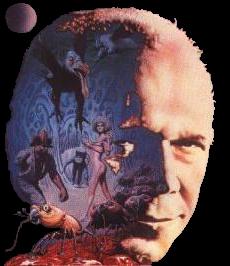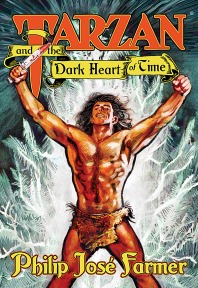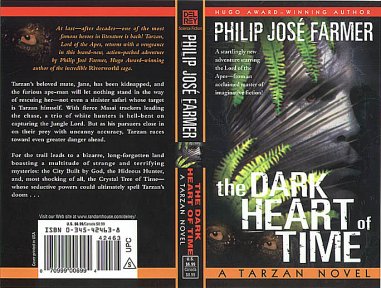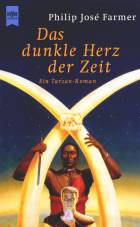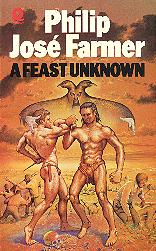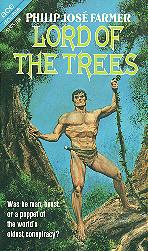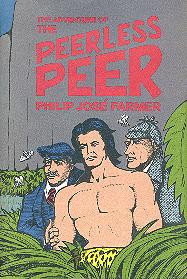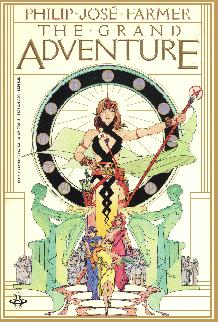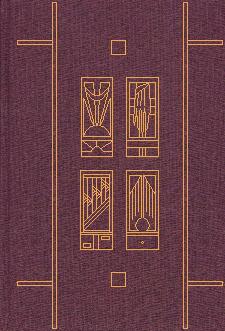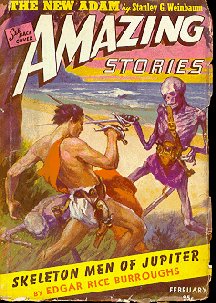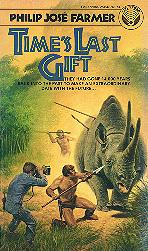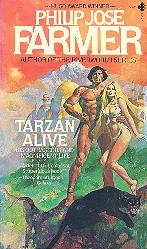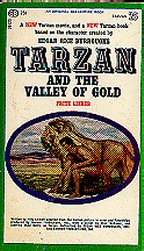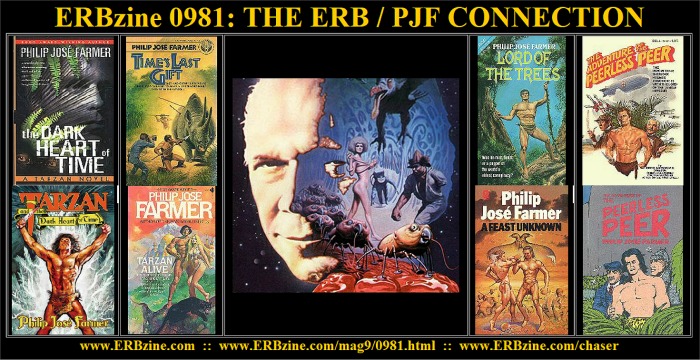From 1974, this is one of Philip Jose Farmer's
better efforts relating his interpretation of classic pulp characters.
At only 127 pages long, it moves briskly enough, with none of the lengthy,
standstill digressions that kept ESCAPE FROM LOKI from having any momentum.
Farmer has toned down the sexual and scatological details quite a bit,
and although he presents his own theories on the vintage heroes, he doesn't
bog the story down with long exposition. In fact, this book is breezy,
rather lighthearted and more fun than most of his pulp-related stories.
The book was first published in 1974, with a Dell paperback
two years later. Although the name 'Tarzan' is carefully never used, the
identity of the "peerless peer'" of the title, Greystoke, Lord of the Jungle,
is overwhelmingly evident. It's widely believed that the Burroughs estate
pounced on this unauthorized use of its prize character and demanded that
the book be withdrawn from circulation and kept out of print. I haven't
seen any actual documented evidence of this, but it is true that Farmer
re-wrote the story into "The Three Madmen" (reprinted in THE GRAND ADVENTURE),
substituting an adult Mowgli for Tarzan. In many ways, the revised story
is an improvement.
The main stars are an elderly Sherlock Holmes and
Dr John H Watson, still being called to serve their country in the dark
days of 1916, sent to track down the escaped German spy Von Bork (from
the canonical Holmes story, "His Last Bow." Farmer gets the pair from Baker
Street pretty much in character, perhaps a bit more snappish and sarcastic,
as enduring the rigors of trans-Atlantic adventure at their age is no treat.
Holmes and Watson encounter half a dozen of the great heroes of adventure
fiction in their struggles across east Africa, and this is where the real
delights of this story lie.
Some of the characters make only a brief cameo of a spoken
sentence or a short paragraph-- Dr Gideon Fell and a very young Sir Henry
Merrivale, for example. Mycroft Holmes is on stage long enough to send
Holmes and Watson on their mission.
On their journey to Africa, they are pilotted by two very
strange Americans. One is a handsome young gray-eyed fellow named Wentworth,
who is clearly G-8. Fighting off a German attack in midflight, Wentworth
suffers a violently hallucinatory attack, thinking he is fighting giant
cockroaches crawling all over the plane, and after landing, he's wrestled
into a straightjacket and carried off raving. Now, certainly fans of G-8,
an established pulp hero with long and healthy sales of his own title,
may not warm up to this presentation. It's like saying James Bond only
daydreamed he got all those beautiful women and his enemies were ordinary
thugs. Feh. On the other hand, G-8's later adventures did get wildly over
the top, featuring skeleton aviators, flying gorillas, leopard-headed men
and much worse. So you can see Farmer's point.
Holmes and Watson also have to deal with 'Kentov', late
of the Czar's espionage service. Wearing "a long black opera cloak" and
"a big black slouch hat", Kentov has a strange way of abruptly appearing
and disappearing without seeming to use the door. Watson notes his own
mind gets foggy when the man appears and he always jumps violently as the
effect clears. Even Holmes shouts, "Confound it, man! Couldn't you behave
like a civilised being for once and knock before entering?"
Although not as hysterical as Wentworth, the Shadow gets
into similar distress by landing their plane on a zeppelin and invading
it. In the furious fighting which follows, we last see the man in black
falling through the fabric of the airship, a gun blasting away in each
fist, laughing maniacally. Watson reflects that "since he was wearing a
parachute, he may have survived."
We also explore the hidden land and fierce warriors of
the Zu-Vendis, from an Allan Quatermain novel by H Rider Haggard. But most
of THE PEERLESS PEAR is taken up with Holmes and Watson trying to make
terms with Tarzan himself. Farmer presents the Apeman quite faithfully
to Burrough's original interpretation, with the exception of a complicated
fraud that Tarzan pulled when he assumed the Greystoke titles. Holmes
deduces this and in effect blackmails Tarzan into a payment of sixty thousand
pounds to keep silent. That takes nerve! The Great Detective sweats as
the Apeman fingers his long knife thoughtfully, but the deal is struck.
There is a brief moment where Farmer shows such real affection
and respect for these characters that it makes up for some of his transgressions.
Watson has fallen for a young blonde held by the Zu-Vendis and he pleads
for Tarzan to help rescue her. The doctor says he will waive his half of
Holmes' fee (that is, bribe). Greystoke laughs and replies, "I couldn't
refuse a man who loves love more than he loves money. And you can keep
the fee."
Unfortunately, the story collapses into inplausible farce
at the end. Threatened by deadly bees and Zu-Vendi warriors, the elderly
Holmes strips naked and paints himself with stripes, then cavorts in an
approximation of the bee's communication dance, using his lense to imitate
their signals....oh, I can't go on. It's dreadful. And the final pun in
the closing paragraph is simply atrocious. Still, for most of the story,
this is enjoyable and well worth seeking out.

